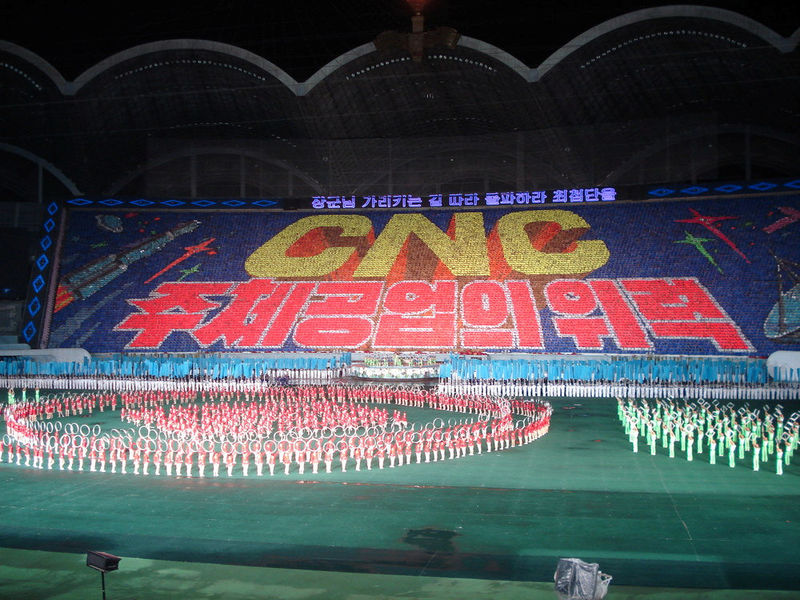By James Pearson (LON:PSON) and Hyonhee Shin
SEOUL (Reuters) - In 2009, a pop video from North Korea celebrated a new national hero - one that outside experts would later realise was at the heart of the secretive state's banned nuclear and missile programmes.(For a graphic on Nuclear North Korea click http://tmsnrt.rs/2lE5yjF)
That hero, widely available in factories across the world, was the Computer Numerical Control (CNC) machine.
Big, grey and boxy, CNC machines use pre-programmed guides to produce intricate parts for everything from automobiles and mobile phones to furniture and clothes. They offer accuracy that human machine tool operators are unable to achieve.
In North Korea, thanks to a combination of homemade technology and reverse engineering, the machines now play a critical role in the weapons programmes. They allow Kim Jong Un to build nuclear bombs and missiles without relying as heavily on outside technical aid or imports.
(Graphic - Kim’s latest act of defiance click http://tmsnrt.rs/2gl7lfy)
Nuclear weapons experts say this has helped him accelerate missile and nuclear testing despite international sanctions on the transfer of sensitive equipment.
"North Korea's centrifuges and new missiles all depend on components made with CNC machine tools," said Jeffrey Lewis, head of the East Asia Nonproliferation Program at the Middlebury Institute of Strategic Studies at Monterey, California.
"(They) are the essential underlying technology for producing missiles and nuclear weapons," said Lewis.
Since 1996, CNC machines have been included in the Wassenaar Arrangement – an international arms control regime aimed at stopping the proliferation of equipment with both civilian and military uses. North Korea is not a signatory.
The country's celebrations of its CNC technology have been fulsome. Hundreds of dancers in luminous orange and green performed the CNC pop song, titled "Break through the cutting edge," at a Korean Workers' Party celebration in 2010. In 2012, the year the South Korean hit "Gangnam Style" was released, the North's CNC title was on karaoke machines nationwide, according to Choson Exchange, a Singapore-based company that trains North Koreans in business skills. The official video for the song opens with a long-range North Korean rocket soaring into a blue sky.
CUTTING EDGE
North Korea likely started to develop its own CNC machines in the early 1990s as part of a drive to build sophisticated missiles and nuclear weapons, nuclear experts say. It probably learned how to make them by taking apart machines it had imported from the Soviet Union.
Its first homemade CNC machine was introduced in 1995. Former leader Kim Jong Il gave the machine the "Ryonha" brand, according to a 2009 article in the country's official newspaper, Rodong Sinmun. That was the first time state media mentioned the technology.
By 2009, the machines had become a mainstay of North Korean propaganda, as Pyongyang launched a nationwide campaign to boost domestic industry. Sanctions were mounting after its second nuclear test and a long-range missile launch that year.
At the time, arms control experts raised concerns about a visit by former leader Kim Jong Il to a North Korean factory where homemade CNC machines appeared to be producing aluminium tubes. These could be used for nuclear centrifuges.
"By around 2010, it seemed they were capable of manufacturing various types of CNC machines," said Kim Heung-gwang, a North Korean defector who taught at Pyongyang's Hamhung Computer Technology University before defecting to South Korea.
But it wasn't until 2013 that the Korea Ryonha Machinery Joint Venture Corporation, which produced the machines, was blacklisted by the U.N. Security Council for supporting the weapons programmes.
And it was only in August this year that U.S. intelligence officials told Reuters North Korea likely has the ability to produce its own missile engines themselves.
Now, Kim Heung-gwang estimates, North Korea has about 15,000 CNC machines. He bases this on North Korean state media reports and photos as well as interviews with more than a dozen defectors who were scientists, professors or factory workers.
MASS PRODUCTION
Pyongyang hailed the homemade machines as a triumph for its governing ideology of "Juche", which champions self-sufficiency. But that wasn't strictly true. In August 2016, state media released photos of Kim Jong Un visiting a factory using CNC machines with the logo of Swiss engineering firm ABB (ABB.UL), one of the leading players in the global CNC machine market. It's not clear when or how the machine reached North Korea.
ABB said the firm respects all applicable trade sanctions against North Korea, and undertakes not to deliver ABB equipment to the country. "That said, we cannot rule out that some of our equipment may have been resold to DPR of Korea without our knowledge or permission," the company said in response to a Reuters inquiry, using North Korea's official title.
A United Nations panel monitoring sanctions on North Korea said in a report this year that Tengzhou Keyongda CNC Machine Tools Co of China had been a supplier of Pyongyang's new CNC machines. A sales representative for Tengzhou Keyongda told Reuters the company stopped selling CNC machines to North Korea four years ago, and no longer maintains trade relations with the country. Despite sanctions, CNC machines are commonplace across North Korean manufacturing and can be brought in through China and Russia, said Lee Choon-geun, a senior fellow at the Science and Technology Policy Institute in South Korea.
The biggest loophole has been that while some CNC machines are banned because they can have both military and civilian functions, most serve civilian industry. "Given their dual-use capability, you could even import the machines for other purposes, take them to pieces and use them however you want," said Lee.
The CNC song highlights this in its opening line: "Whatever it is, once we put our mind to it, there's a programme to make it," it says.
(By James Pearson and Hyonhee Shin in SEOUL; Additional reporting by Matt Spetalnick and David Brunnstrom in WASHINGTON, Lusha Zhang in BEIJING; Editing by Soyoung Kim, Lincoln Feast and Sara Ledwith)
